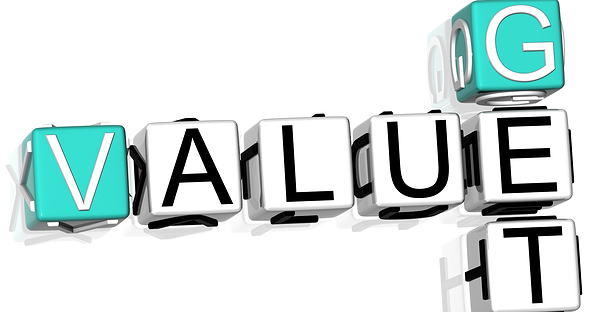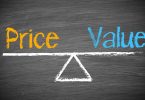How to avoid giving your products away
By Steve Rankel
Oscar Wilde once said “A fool is someone who knows the price of everything but the value of nothing.” We live in a world that seems more often to focus on price and not value. Today, 2.5 cents of every dollar spent in the US is at Wal-Mart (the low price leader) creating a trend marketers need to fight against. No one is immune to the Wal-Mart effect. Wal-Mart sets the pace and pattern for corporate performance. Fortune’s Jerry Useem writes, “How Wal-Mart thinks has never been a big mystery. Buy stuff at the lowest cost possible, pass the gains on to the consumer through super-low prices, and watch the stuff fly off the shelf at insane velocity.”
How can you sell value in a Wal-Mart world and avoid giving your products and services away in bidding wars? Let’s talk about it.
Our Agenda Today:
- The Definition of Value & Value Pricing
- The Fluctuating Nature of Value
- Symptoms of Value & Value-Pricing Problems
- Components of Value That Directly Influence Price
- Your KVP: Defender of Value-Pricing
- Steps to Integrate Value Pricing and Value-Based-Selling Into Your Company
- Additional Resources
1. The Definition of Value & Value Pricing
The American Heritage Dictionary defines value as:
- An amount, as of goods, services, or money, considered to be a fair and suitable equivalent for something else; a fair price or return.
- Worth in usefulness or importance to the possessor; utility or merit: the value of an education.
Too many pricing exercises start with the first definition ?looking to the market to tell us what is a “suitable equivalent” or “fair price” for a product. Big mistake. Value pricing means pricing your products and services based on the second usage definition “the worth in usefulness or importance to the possessor.”
In Business Kinetics’ client work, we first identify value components important to customers, and back into specific pricing models. I will explain more on this in a moment.
Let’s look at an example of how value changes with time and place.
2. The Fluctuating Nature of Value
In my previous article; ‘Using a Compelling Killer Value Proposition‘, I presented a metaphor on how customer values change based on their situation. Let’s revisit this for a minute. Suppose someone knocks on your door, while you’re comfortably at home and offers you a choice of a tank of gas or $100,000. Which would you take? The money of course. It?s far more valuable than a tank of gas.
Now, let’s change the scenario. You are visiting Egypt with your spouse and children. You’ve rented a Range Rover to visit the pyramids 50 miles outside of Cairo. Unfortunately, you run out of gas on the way and end up waiting hours for help in the hot desert sun. Then, your 6-year old daughter faints. Suddenly, a nomad on a camel appears over the horizon.
I would like to help you’, the nomad says. ‘I can offer you this $100,000 gold bar, or this canister full of gasoline.?
Which would you choose now? Gas please!
Thinking back to the American Heritage dictionary, remember: Worth in usefulness or importance to the possessor; utility or merit: the value of an education. In our example, gasoline is worth much more than gold. This will not always be the case for these customers. Currently, it is likely you have a product or service that requires an evaluation of its value. What is it? How can you articulate the value to your customers? Return to the exercise by thinking value from the customer’s perspective.
3. Symptoms of Value & Pricing Problems
Indicators of value problems include:
- Your sales team has to wage a price war to win new customers
- You find yourself often in competitive bidding situations where it’s hard to differentiate from other players in the battle
- Customers often ask “what’s the price?” before they ask anything else
Now, some of these can be evidence that you are in the wrong market. In reality, even if you’re in the right market not everyone is going to buy from you. But, all things being equal, they often indicate confusion in the minds of customers as to the value or benefit of a product or service on their business.
4. Components of Value That Directly Influence Price
Value is most certainly in the eye of the beholder. This beholder is the customer. Yet, too often, this is where our journey stops. We say the customer is only willing to pay $10,000 or $100,000 for this class of software / product / service. This leaves open a number of other critical factors that influence customers’ perception of value.
Let’s look at 5 key factors that directly influence value and pricing:
- Uniqueness / Specialness
- Scarcity
- Trust
- Proximity
- Pain relief / Opportunity delivery
Uniqueness / Specialness
Clearly, when you have a one-of-a-kind product or service, you will have an easier time justifying value and pricing for bottom-line buyers. You must clearly link the value to the customer’s business. Obviously, to maintain a product’s uniqueness you need to continue investing in product development. Witness Apple’s Newton creating the handheld / palmtop class of devices, later eclipsed by Palm and the PocketPC. What uniqueness can you offer? How can you differentiate what you have so that you avoid the pricing wars or perception of being the same as your competition?
Scarcity
This component of value was clearly demonstrated in our gas and $100,000 example above. When something is scarce, it is valuable. The new low-end Mini Cooper has a list price of something around $17,000. Why then are US West-Coast dealers getting $25,000 or more per car? Because BMW limits their production. Thus driving up the price. Can you do this? Consider how to build in scarcity in your product-marketing model.
Trust
Fact. If people trust you, they will pay more for your product or services. A good example of this is in the automobile industry. Why do people pay the same amount of money for a used Toyota as they do for a new Kia with a 10-year warranty? Because they trust Toyota reliability and years of quality initiatives. Kia is trying to accomplish the same thing by offering a 10-year warranty, the purpose of which is to eliminate worries about reliability. Dependability happens to be one of the major purchasing factors for car buyers. Will Kia’s strategy work? Only if they are able to raise the value of a 10-year warranty in the minds of the consumers. How effective is a 10-year warranty if the automobile is in the shop for the next 10 years?
Trust is the same reason people buy IBM over cheaper alternatives. Ever hear of the phrase “nobody ever got fired for buying IBM”? It’s because IBM is reliable, like buying an insurance policy for your career or business. And the security outweighs the risk involved in a cheaper alternative.
Pain Relief / Opportunity
A product?s ability to reduce pain, or create opportunity, can overcome other lacking factors . Customers will take a risk on a product they haven’t heard of if the potential reward outweighs the risk. The most successful salespeople intrinsically translate a product or service’s impact on the customer’s business into value the customer understands. Do this for them, and ALL your salespeople will sell more.
Proximity
You’ve got to be in a buyer’s path when they are seeking a solution, rather than just using ‘push selling’ (pursuing customers and then flogging them to buy your product when you need to make revenue numbers vs. when they have a need). Case in point – when you stop for a break on a 300-mile trip, you walk into a gas station and pay $1.00 for a 12oz Coke. Those same 12 oz. of Coke cost about $0.15 in a supermarket down the road. Why the difference? Proximity.
If you can place products customers want in their path when they need it, they will be less price sensitive. Despite the fact that the US Postal Service offers cheaper overnight service, FedEx still holds the lion’s share of the market. Why? FedEx picks up packages at your place of business. And despite the higher price, people will pay for that proximity and avoid the trip to the post office.
How can you build in proximity to your product pricing?
5. Your KVP: Defender of Value Pricing and Creator of Unfair Advantages for Your Products
Your KVP (Killer Value Proposition), when clearly communicated to an economic buyer, is one of your chief defenders against price wars, me-too marketing and being viewed as ‘just another product in a sea of choices.’ Your KVP needs to answer the following question: Why should I do business with you, and purchase your product or service, as opposed to choosing any other option, including the option of doing nothing at all?
Business Kinetics regularly helps clients create selling situations to give them an unfair advantage. This is due to the KVP being presented to the right economic buyer. This process can make price the last and least important step of the selling process. Be sure of this: without a KVP that helps you stand apart from the pack, you will live in the world of pricing wars and buyer indifference for a long time.
6. Steps You Can Take to Integrate Value Pricing and Value-Based-Selling Into Your Company
So, now you’re convinced that you want to do value-based pricing in your business. How do you do it? These 5 steps are not easy to do right, but when you do them correctly, you will win big.
a) Conduct customer research to establish what customers value
You must get inside customers’ heads and figure out things they value beyond simply ROI and obvious metrics. The unspoken needs. This will often produce answers you don’t expect and you shouldn’t be surprised if they have nothing to do with money or ROI. Safety, security, 24-hour access, for example. Many times these are worth a great deal to your customers. Ask.
b) Translate customer response into value components
We work with clients to translate customer responses into value components that can be emphasized in their marketing and sales efforts. Value components are listed above and we have a Value Component Analysis Tool available free of charge if you email me at [email protected].
c) Look for opportunities to use anchoring techniques in your marketing
Anchoring is a technique used to establish the relative value of things in our mind. It’s much like word association. Your customers unconsciously associate your product or service with some other related term. This might be a product or service more expensive than yours (if you’re lucky). For example, if someone says to you ‘Mercedes Benz’ you immediately think of high-end, luxury. This helps Mercedes sell their smaller vehicles at a premium.
d) Emphasize Business Impact In Your Marketing
In a study of 30,000 salespeople, researchers discovered that top performers outshine those who missed quotas because of an innate ability to communicate the value and impact of a product or service on a customer’s business. Be sure your marketing and sales tools emphasize these points.
e) Educate and Equip Your Salesforce with Tools that Support Value-Based Pricing
When you begin using value pricing (or re-pricing) for your products or services, you must provide the sales force with both training and tools that support these efforts. If you don’t, they will find themselves back in the bidding wars you are trying to avoid. Sales (and channels) will need tools that emphasize value; your KVP; and the value components your customer research uncovers. This will take work, but it will be worth it.
7. Additional Resources
The topic of creating value-based pricing and supporting tools is so deep that it’s difficult to squeeze all the facts into a short article. For a worksheet to analyze value components important to your customers and market just email me at [email protected] and I’ll forward a copy.
Also, you are welcome to join us for an AIPMM-sponsored Teleseminar this Thursday, February 26th at 11:00am EST on ‘Developing a KVP (Killer Value Proposition).’ This Teleseminar will address value, value pricing, value components and various other factors in providing you with a competitive advantage. To register go to www.product180.com and use AIPMM as the registration code.








